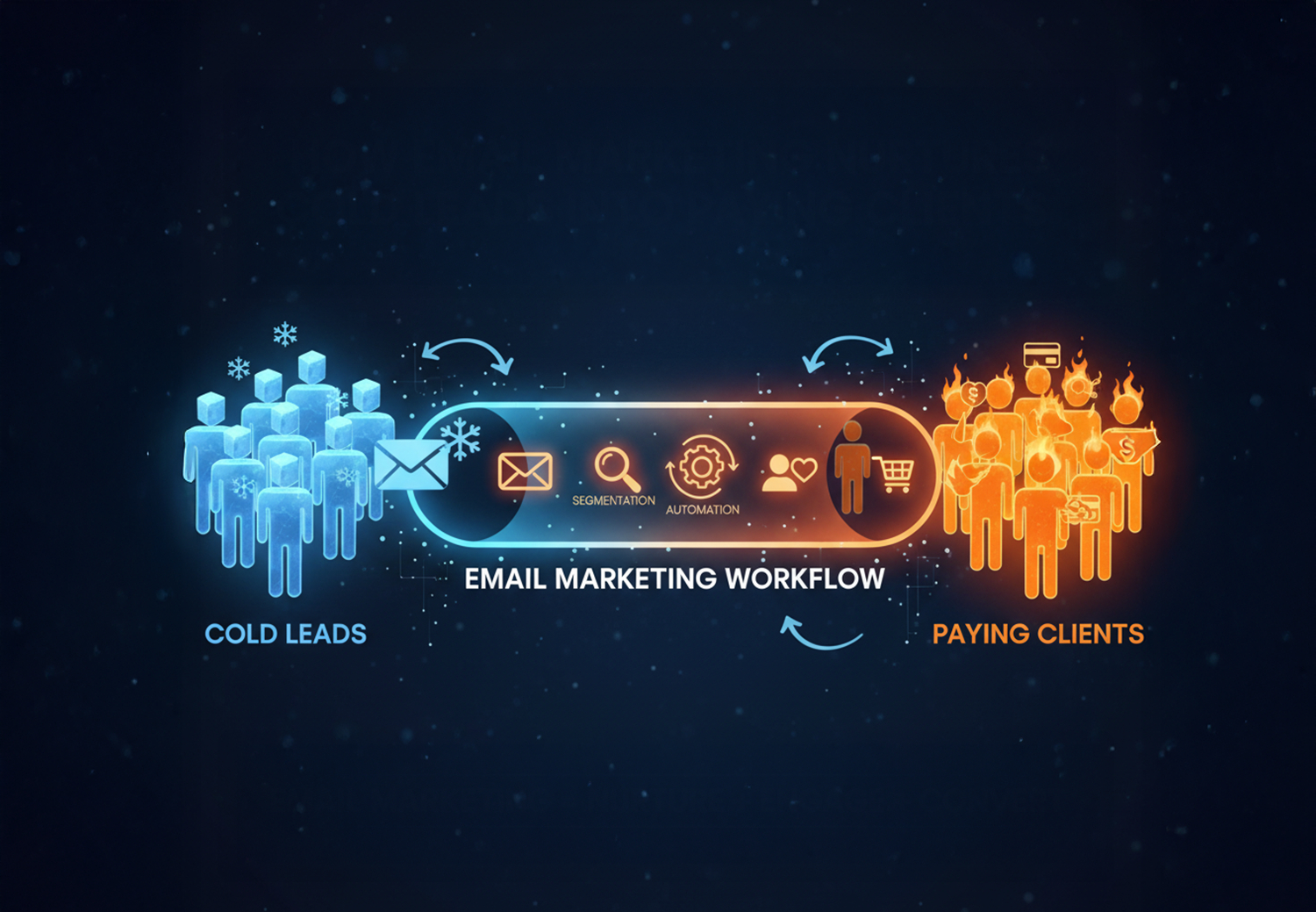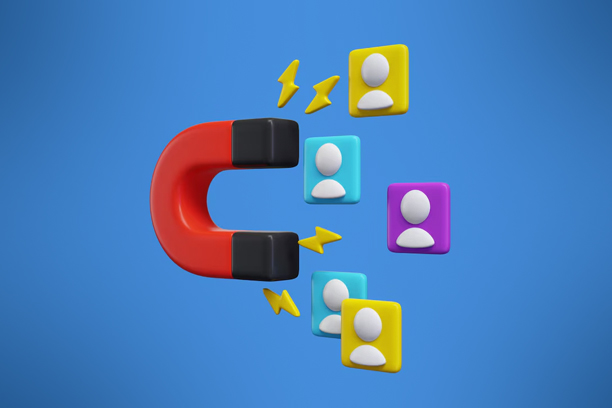Work Hours
Monday to Friday: 9AM - 6PM
Weekend: Closed

Every business wants more leads. But what happens when the leads don’t convert right away?
These are called cold leads – people who’ve shown interest but haven’t yet made a move. They may have downloaded a resource, clicked an ad, or visited your website, but they’re not ready to commit. Rather than letting those opportunities go cold, email marketing offers one of the most powerful, cost-effective ways to nurture and convert them. When used strategically, email campaigns move cold leads through the funnel—educating, engaging, and ultimately turning them into clients.
Let’s explore how workflows, segmentation, and personalization come together in the journey of converting cold leads into loyal customers.
What Are Cold Leads?
Cold leads are individuals or businesses that have entered your system but haven’t taken significant action beyond the first touchpoint.

They may have:
- Signed up for your newsletter
- Clicked on a PPC ad
- Downloaded a free resource
- Abandoned a cart or inquiry form
- Visited your pricing or service pages
These leads aren’t unqualified—they’re simply unready. They may not fully understand your offer yet or trust your brand. That’s where nurturing becomes essential. Email marketing helps guide these leads from passive interest to active engagement, without being pushy or intrusive.
Why Email Marketing Works for Cold Leads
Email remains one of the most direct and personal communication channels, especially when it comes to building relationships over time.
Here’s why it’s ideal for nurturing cold leads:
- Cost-effective: Email boasts a high ROI—$36 for every $1 spent (Litmus).
- Personal: You can tailor content based on behavior, preferences, and needs.
- Automatable: Email workflows run on autopilot but still feel human.
- Trackable: You can measure open rates, click-throughs, and conversions.
Cold leads need trust, information, and gentle nudges. Email delivers all three – at scale.
Step 1: Mapping the Lead Journey
Before launching any email campaign, it’s important to understand where your lead is in the funnel. This helps determine what kind of messaging and content they need.
Example Journey:
- Awareness Stage – Cold lead downloads an industry checklist
- Consideration Stage – Receives case study and blog content
- Decision Stage – Offered a free consultation or product demo
Each step in the journey should build on the last. Mapping these touchpoints lets you design an email workflow that moves leads from cold to warm, and eventually, to hot.
Tip: Use a visual flowchart to map your workflow before writing emails.
Step 2: Segmenting Your Audience
One of the biggest mistakes in email marketing is treating every subscriber the same. The more targeted your emails, the more effective they’ll be.
How to Segment Cold Leads:
- By Behavior: What did they click? Which pages did they visit?
- By Demographics: Industry, company size, job role, etc.
- By Funnel Stage: First-time visitor vs. returning lead
- By Interests: Which service or product did they engage with?
Example:
- Segment A: Leads who viewed your service pricing page
- Segment B: Leads who downloaded an SEO audit template
Each group should receive a sequence that’s relevant to their behavior and needs.
Step 3: Crafting Personalized, Value-Driven Emails
Personalization goes beyond inserting someone’s name into the subject line. The goal is to make the recipient feel like the email was written just for them.
What Personalization Can Look Like:
- Referring to the exact content they downloaded
- Mentioning a relevant challenge based on industry
- Providing a tailored resource or solution
- Sending different offers based on behavior
Anatomy of a Lead-Nurturing Email:
- Subject Line: Clear, relevant, and curiosity-driven
- Intro: Speak to their pain point or interest
- Main Content: Share a resource, blog, or tip that helps
- CTA: Invite to take the next step (e.g., “Explore Your SEO Audit”)
Example Email Sequence:
- Email 1 (Day 1): “Thanks for downloading our SEO Checklist—Here’s how to use it effectively.”
- Email 2 (Day 3): “5 ways businesses improve Google rankings with technical fixes”
- Email 3 (Day 6): “Client case study: From 2K to 50K monthly visits in 6 months”
- Email 4 (Day 10): “Let’s talk—Get a free website SEO review”
Pro Tip: Use tools like dynamic content and conditional logic to change messaging based on user data.
Step 4: Using Automation to Scale Effectively
Email workflows let you send the right message at the right time—automatically. This saves time while improving consistency and engagement.
Common Triggers for Workflows:
- A form submission
- A specific link click
- Visiting a product or service page
- Inactivity after a certain number of days
Tools for Automation:
- Mailchimp
- HubSpot
- ActiveCampaign
- Klaviyo
- ConvertKit
These tools allow you to:
- Set behavior-based triggers
- Send drip campaigns
- Pause or skip emails based on responses
- Conduct A/B testing for subject lines and CTAs
Automation enables personalization at scale, critical for turning cold leads into warm, sales-ready prospects.
Step 5: Monitor, Optimize & Close the Loop
No campaign is ever perfect from the start. That’s why tracking performance is essential.
Key Metrics to Track:
- Open Rate: Are subject lines working?
- Click-Through Rate (CTR): Is the content engaging?
- Conversion Rate: Are leads taking action?
- Unsubscribe Rate: Is frequency/content pushing people away?
Use this data to:
- A/B test email formats or CTAs
- Refine audience segmentation
- Improve future campaigns
Best Practice: Sync your email platform with your CRM or sales tool. This way, your sales team knows which leads are warm and what content they’ve seen.
Common Email Marketing Mistakes to Avoid
Here are some pitfalls to watch for when nurturing cold leads:
- Sending the same email to everyone
- Over-emailing or spamming
- No value in content (all sales, no education)
- Unclear call-to-action or next step
- Poor mobile formatting or broken links
Fixing these ensures your emails aren’t ignored or flagged as spam.
Conclusion
Email marketing isn’t a magic switch—it’s a strategic process. Nurturing cold leads through segmentation, personalized workflows, and automation allows you to build trust over time. When done right, these efforts translate into higher conversions, stronger client relationships, and a more efficient sales pipeline. It’s not just about sending emails. It’s about sending the right email to the right person at the right time.
Need Help Building Your Email Lead-Nurturing Funnel?
Segnant specializes in building data-driven email marketing campaigns tailored to your audience and goals. Whether you’re struggling with cold leads or need help scaling your email strategy, we’re here to help. Book Your Free Consultation Today

